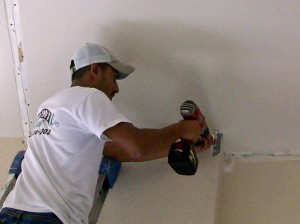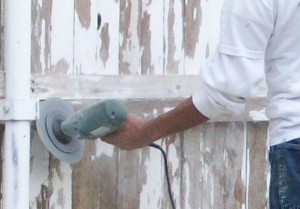
How to repaint water-damaged surfaces

If the water damage is at a drywall seam and nails have begun to pop, remove all those nails and replace with new nails or screws.
Exterior paint protects buildings from rot, mold and damage to the structure, but peeling paint is a good indicator that there’s damage below the surface and a careful inspection of the area is needed.
When it comes to how to repaint water-damaged surfaces, a quick identification of the problem, repairing or replacing the problem area, proper prep work, and priming and painting can prevent even more costly repairs.
Problem: There are water-damaged surfaces where the ceiling meets a wall.
Solution
While most building materials aren’t harmed by short-term exposure to water, plaster and drywall are quickly damaged. Before repainting, find the source of the leak and repair it.
If the water-damaged surfaces are at a drywall seam and nails have begun to pop, remove all those nails and replace with new nails or screws. Don’t try to re-sink the nails, you’ll damage the drywall further.
Remove any loose tape and scrape off any loose texture with a putty knife. Use mesh tape to repair angling cracks and paper tape to repair drywall seams. Spread the compound thinly, covering all edges. Allow plenty of drying time and sand smooth between coats.
If texturing is required, make sure you shake the can of spray texture for a couple minutes and then screw the nozzle into the valve stem. Hold the can 9 to 14 inches away from the surface and squeeze the trigger with quick half-second bursts while sweeping over the repaired area. Allow to dry for 24 hours before painting.
For small areas, use paint of the same brand and finish for an exact match. If you are repainting the entire area and the client specifies a drastic color change, you’ll need to prime the area. Some colors require a P-Shade primer for proper topcoat color development. Paint when the room temperature is above 50 degrees F.
Problem: Paint is peeling from water-damaged surfaces on an exterior wall.

After protecting adjacent areas to keep them clean and putting on appropriate safety equipment, sand and scrape all loose, chipped and peeling paint from the surface, and repair or replace any damaged pieces of the structure.
Solution
Peeling paint often results from poor surface preparation or application of oil-based paint on a wet surface.
It can also occur when moisture gets behind the paint film because of missing caulk, leaks in the roof or wall system, faulty gutters, missing ventilation or water back-up.
Once you’ve found the cause of the paint problem and fixed it, prepare the work site and the surface to repaint water-damaged surfaces. Cover walks, driveways, decking, steps and landscaping near the area to be repaired.
Sand and scrape off all loose paint with a sander and 4-inch putty knife. (Always wear a dust mask, earplugs and safety glasses when sanding and scraping.) Replace any rotten wood.
Add a bleach detergent solution to your pressure washer and use the low-pressure soap nozzle to completely soak the surface. Let the solution stay on the surface for at 5 to 10 minutes, but don’t let the surface dry before rinsing it. If necessary, re-spray the area.
Then, using the appropriate high-pressure nozzle, rinse the surface. Once the surface is completely dry, spot prime any bare areas to protect the wood and provide a better surface for the topcoat to adhere to. Follow the drying time recommended for the primer before applying the topcoat.
To repaint, one coat of high-quality acrylic latex paint is probably adequate. Bare surfaces will likely require two coats. Again, be sure to allow proper drying time between coats.
Use good quality exterior primer and paint that contain UV inhibitors and are designed to stand up to the elements. Apply at temperatures above 35 degrees F and below 80 degrees F. Do not apply in direct sunlight.
–By Ignacio Moreno, president of Nacho’s Painting Service, www.nachospainting.com
Recommended supplies
- Brush: Nylon/polyester 2½ inches
- Roller: Use a 3/8 to ¾-inch nap synthetic roller cover
- Spray – Use an airless sprayer with a .017- to .021-inch tip (interior) or .015- to .019-inch tip (exterior) at 2000 psi

